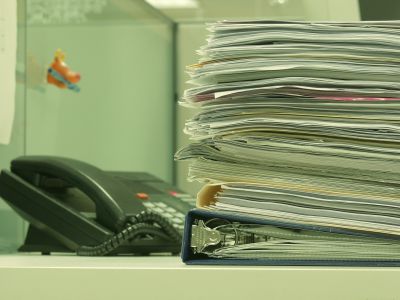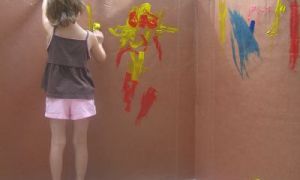Part of being a childcare professional is to maintain and complete paperwork. However at times this can be easily said than done. More often than not paperwork such as observations, programming, evaluations, daily diaries etc can become overbearing to complete during the course of our busy day and quite often you may find yourself falling behind.
Sometimes the only way you may think to catch up on paperwork is to take it home and complete it. However, for most of us already working an 8-10 hour day, the last thing that you would want to do is spending another couple hours completing documentations at home instead of going home and relaxing. I believe that all paperwork should be completed during the day while working. In saying this, I completely understand that on some days finding time to complete paperwork while at work can be difficult. Completing paperwork doesn't have to be so hard! It’s all about managing your time around your day to ensure the paperwork that you need to complete on a daily basis can be done...
This article (with the request of our members), will provide you with hints and tips to ensure you can complete paperwork efficiently and effectively throughout your day at work. It will provide you with some practical strategies you can use within your childcare centre and how to cut down on the time spent completing paperwork which will enable you to make sure that all your required documentation paperwork can be completed by the time you walk out the door by the end of the day.
Prioritizing Paperwork
When you arrive at your centre in the morning, spend a few minutes prioritizing paperwork that needs to be completed by the end of the day. For me, I use a ‘post it’ pad to write down a “To –Do List” with the list of paperwork that needs to be complete by the end of that day. Try not to worry about the paperwork for the overall week, just focus on one day at a time. For example, I’ll jot down names of children that I will need to observe, evaluations I will need to complete, possible learning stories that can be documented etc. Now I know it seems like even more writing, but sometimes with so much other stuff going on it’s easy to forget things. So a “To –Do List” will help to prioritize and focus on the paperwork that needs to be done for that specific day.
Delegating Paperwork
As a room leader, I find it impossible to manage and complete paperwork all on my own. I require the help of the fabulous staff in my room and this is how I manage to complete paperwork by the end of the day. I completely understand that as a room leader, you may think that YOU need to complete paperwork (observations, programming, evaluations etc.) all on your own but this isn't the case. Delegate paperwork to others who work in the room with you, they might not have the same qualification or experience as you but sharing the workload will ease the pressure and stress. For example, child observations can be easily delegated to other staff as well as writing up the daily diary. If the other staff in the room with you don’t know how to complete observations or the daily diary (for example) then teach them! Share the duties and this will give you time to focus on other paperwork that needs to get done such as learning stories, portfolios etc. If you have more than 2 staff in the room with you, I suggest you write up a “time table” of who completes what paperwork each day. I know it may seem a little childish but if this helps get the paperwork done then by all means do it. In the “time table” write down the paperwork tasks that each staff in the room needs to complete by the end of that day.
Cutting Down Paperwork On Observations
As you are all aware, child observations need to be completed each day. Depending on the number of children in your care, you may have only 1 or 2 child observations to do a day. However, if you are working at a bigger centre you could have up to 4 to 5 observations a day… The most efficient and effective way to complete child observations is to get them done in the morning itself. Use a post it pad to jot down a few points to help you remember the events that occurred (for the observation) and take a couple of photos (this will also help you to remember).
Now when completing a child observation, typically you would quickly write down the observation on a scrap piece of paper and then write it up nicely in the observation format. Well, this is a waste of time because you are doubling up on the same work…That’s why I previously suggested that you jot down a few points and take a couple of photos to jog your memory (or) another way is simply write the observation straight onto the observation format. It doesn’t have to be written up nicely (although you have to be able to read it). This saves you having to re-write it again later. It’s a good idea to have a few clipboards with blank child observation formats around your room and outside, so you can easily grab it and write down the observation itself. Once you have completed the “observation part”, you can work on the evaluation and the follow up experiences later. However if you are able to complete it then and there, best to do it straight away…
Another option that is available to you rather than “writing up” individual child observations in detail which does take a lot of time is to simply take a photo observation. Photo observations can cut down a lot of time you spend writing the actual observation itself. When taking a photo observation all you need to include are the child’s responses to a few open-ended questions you ask about what they are doing. This gives the child an opportunity to describe their experience in their own words. For e.g. you could ask questions like:
- Tell me about it…
- How did you…
- How could you…
- Then what…
- What do you think about…
- Why do you think this happened…
Add these responses to the photo; link the observation to the EYLF Learning Outcomes, Principle and Practice and lastly provide a brief sentence on how you will extend the child’s learning. By doing it this way, you will cut down your paperwork on child observations in half as you won’t have to spend so much time writing.
Cutting Down Paperwork On Daily Diary
This is an important part of your daily documentation that needs to be complete by the time parents start arriving in the afternoon. Try and spend no more than 15 minutes completing this and only focus on the experiences that were meaningful and popular for that day (if you have the same activity set up for the entire week you don’t need to mention it in each daily diary, just once is enough) as well as any spontaneous experiences or children’s interests that arose. You should be able to complete the daily diary from the top of your head. It’s also a great idea to take photos (5 to 6 should be more than enough) to help you write your daily diary and you could use these photos to explain the day’s events. The best time to write the daily diary is during rest time because more often than not, most experiences are often completed by this time. Another option is to write your daily diary as experiences take place throughout the day. Simply write a paragraph or a couple of sentences as the children interact and play with the experiences you have setup in the room. This process will also come in handy when writing down children’s comments and evaluating experiences. When completing your daily diary in small portions, by the time rest time comes around, your daily diary should more or less be completed and you don’t have to worry about it (except maybe for adding photos).
Cutting Down Paperwork On The Curriculum Plan
Whether you're doing a weekly or daily curriculum plan, always have next week’s (or) next day’s curriculum plan close by. As you come up with experiences that you would like to implement for the following week (or) the following day you can write it straight onto the curriculum plan. This also includes experiences that children have enjoyed throughout the week, child input (if a child has requested a particular activity or piece of equipment), follow up for child observations etc. Try not to leave it to the end of the week. Even if you jot down 1-2 activities a day onto the next weeks (or) next day’s curriculum plan by the end of the week your program will be complete. Also if you're a room leader let other staffs add to the curriculum plan as well. Another thing is don't worry about typing the curriculum up. Just hand write it if it's a lot quicker. Do whichever works best for you. I would also like to mention that at the beginning of the week (or) beginning of the day if your curriculum plan doesn't have many experiences on it then don’t worry… throughout the day (or) week you can simply add any spontaneous experiences that arise directly onto the curriculum plan. Any changes, anything added, anything requested should all be added onto the weekly (or) daily curriculum plan when it occurs.
Managing Portfolios
Completing portfolios can sometimes be a challenge especially when there is so much documentation to add to each child’s portfolio. The best way to complete children’s portfolios is to simply work on 2-3 a day rather than trying to complete them all in one go. I suggest that you team your portfolio’s up with the child observations. So when you’re doing the children’s observations each day then on the same day complete their portfolios. That way you don’t have to worry about it and you can do them as you go. -
Hints and Tips On Managing Paperwork
- Use your time constructively – On days where you have an extra member of staff, you can use that time to complete paperwork. During the afternoon if 2 rooms combine to go outside and play and there is sufficient staff to supervise the children, take some paperwork out into the playground and try and complete it. If you do take some paperwork out into the playground to complete let staff know what you are doing because during this time you will not be able to efficiently supervise children as you will be more focused on the paperwork.
- Not everything needs to be typed – If you don’t have access to a computer then don’t worry… Just use handwriting for your documentation, it may not be as professional as typing but as long as it is done, it doesn't matter.
- Work out “off the floor” time – Talk to your director and work out one day a week, that you could possibly get some time to complete your paperwork. Your director will simply take over your position for an hour or so, so you can have some “off the floor time”. If your director is unwilling to do this (which I find very surprising) work out with the room leaders of the other rooms, where staff members can fill in for each other on not so busy days so everyone can get some time off the floor to complete paperwork.
- Try and complete paperwork on time – Try and come up with a schedule on when you would want to have each paperwork task complete and stick by it. For example, completing 2 observations by morning tea, completing the daily diary while the children are eating lunch etc.
- Manage your lunch break – I’m all for, enjoying a lunch break without the distractions of the children and having to worry about completing paperwork but in all fairness I believe that if you can’t find time to complete paperwork during the day then do it on your lunch break. Typically for most of you, 30 minutes of your break is unpaid so you’re entitled to have that 30 minutes as your own time. However, for those of you who are getting a paid lunch break then you should use that time to complete any work that hasn't been done. Technically speaking, during your paid break if you are needed to work then I believe that you should. I think 15 – 20 minutes to sit down, eat lunch and de-stress is more than enough time. The rest of your break should be getting everything else complete. Now, I know it may seem unfair but I rather lose out on my break than take work home to complete at night… just manage your time…
The documentation and paperwork that we complete on a daily basis is required legally by law and regulations and there isn't one we could just simply ignore. It all has to be done. It’s not easy to manage and maintain paperwork especially when this job requires us to do so much more, such as interact with the children, deal with any accidents, supervise children, follow their interests, follow up on spontaneous experiences, guide children’s behaviour… the list keeps going and going.
It will take some time to adjust to the paperwork and work out ways to complete it on time and remember to share the workload!



 Here is the list of the EYLF Learning Outcomes that you can use as a guide or reference for your documentation and planning. The EYLF
Here is the list of the EYLF Learning Outcomes that you can use as a guide or reference for your documentation and planning. The EYLF The EYLF is a guide which consists of Principles, Practices and 5 main Learning Outcomes along with each of their sub outcomes, based on identity,
The EYLF is a guide which consists of Principles, Practices and 5 main Learning Outcomes along with each of their sub outcomes, based on identity, This is a guide on How to Write a Learning Story. It provides information on What Is A Learning Story, Writing A Learning Story, Sample
This is a guide on How to Write a Learning Story. It provides information on What Is A Learning Story, Writing A Learning Story, Sample One of the most important types of documentation methods that educators needs to be familiar with are “observations”. Observations are crucial for all early childhood
One of the most important types of documentation methods that educators needs to be familiar with are “observations”. Observations are crucial for all early childhood To support children achieve learning outcomes from the EYLF Framework, the following list gives educators examples of how to promote children's learning in each individual
To support children achieve learning outcomes from the EYLF Framework, the following list gives educators examples of how to promote children's learning in each individual Reflective practice is learning from everyday situations and issues and concerns that arise which form part of our daily routine while working in an early
Reflective practice is learning from everyday situations and issues and concerns that arise which form part of our daily routine while working in an early Within Australia, Programming and Planning is reflected and supported by the Early Years Learning Framework. Educators within early childhood settings, use the EYLF to guide
Within Australia, Programming and Planning is reflected and supported by the Early Years Learning Framework. Educators within early childhood settings, use the EYLF to guide When observing children, it's important that we use a range of different observation methods from running records, learning stories to photographs and work samples. Using
When observing children, it's important that we use a range of different observation methods from running records, learning stories to photographs and work samples. Using This is a guide for educators on what to observe under each sub learning outcome from the EYLF Framework, when a child is engaged in
This is a guide for educators on what to observe under each sub learning outcome from the EYLF Framework, when a child is engaged in The Early Years Learning Framework describes the curriculum as “all the interactions, experiences, activities, routines and events, planned and unplanned, that occur in an environment
The Early Years Learning Framework describes the curriculum as “all the interactions, experiences, activities, routines and events, planned and unplanned, that occur in an environment


